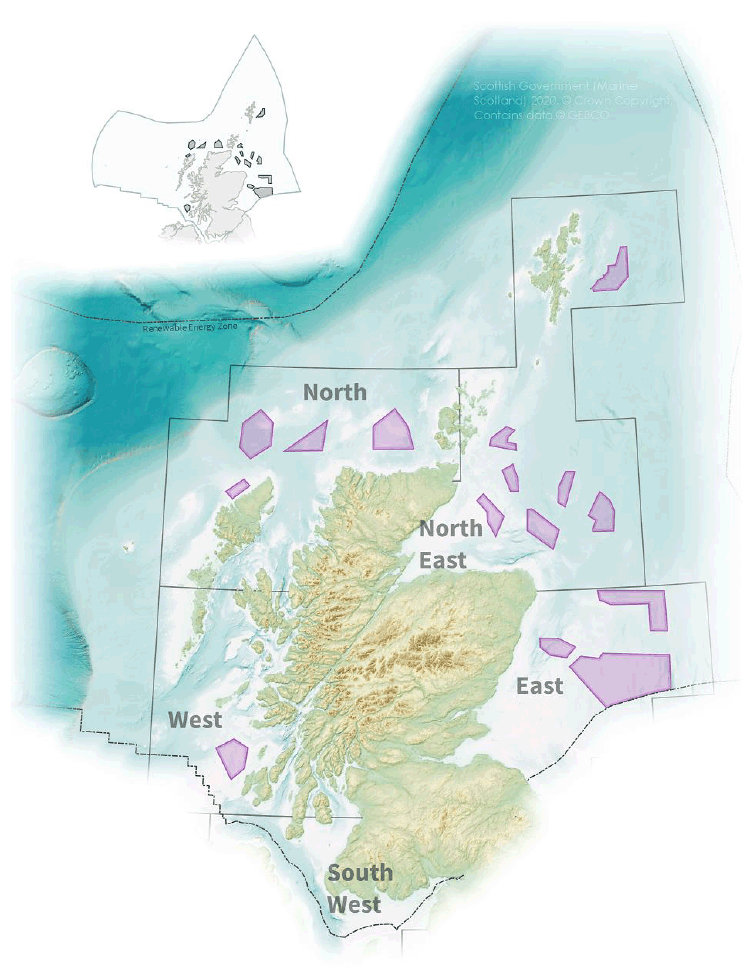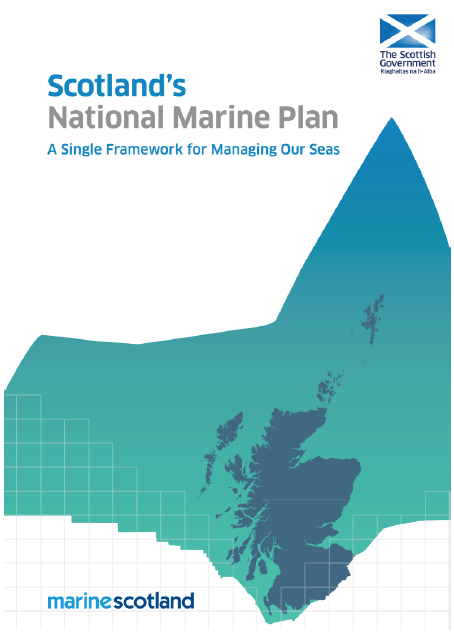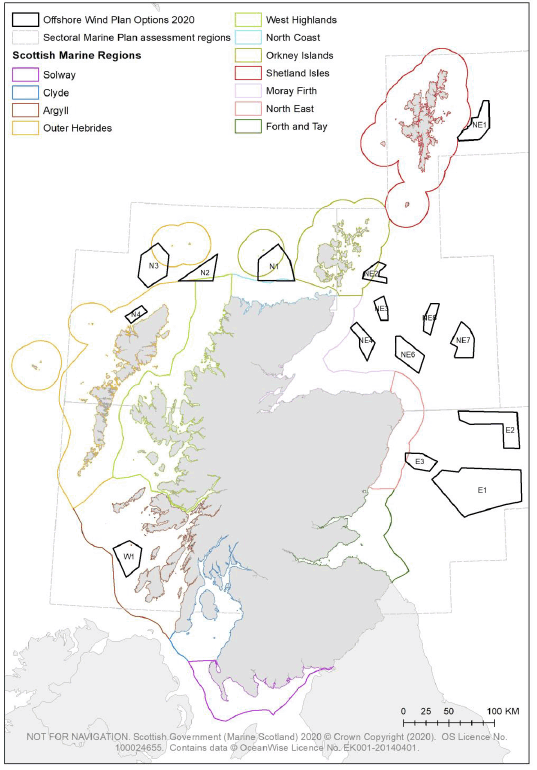Sectoral marine plan for offshore wind energy
Aims to identify sustainable plan options for the future development of commercial-scale offshore wind energy in Scotland, including deep water wind technologies, and covers both Scottish inshore and offshore waters.
2. Plan
2.1 Purpose and vision
The Plan aims to identify sustainable plan options for the future development of commercial-scale offshore wind energy in Scotland, including deep water wind technologies, and covers both Scottish inshore (Scottish territorial waters or within 12 NM from shore) and offshore waters (extending out to the Exclusive Economic Zone limit).
This Plan seeks to contribute to the achievement of Scottish and UK energy and climate change policy objectives and targets, through the provision of a spatial strategy to inform the seabed leasing process for commercial offshore wind energy in Scottish waters, which;
- Minimises the potential adverse effects on other marine users, economic sectors and the environment resulting from further commercial-scale offshore wind development; and
- Maximises opportunities for economic development, investment and employment in Scotland, by identifying new opportunities for commercialscale offshore wind development, including deeper water wind technologies.
This Plan has been developed to ensure consistency with the objectives and principles set out within Scotland’s National Marine Plan (2015) and the UK Marine Policy Statement (2011).
Figure 2 Plan Vision Statement
2.2 Plan Options
This Plan identifies 15 Plan Options ("POs"), split across 4 regions (see Figure 3), which are capable of generating several GW of renewable energy.
As a result of consultation feedback, amendments were made to the boundaries of 7 of the Draft Plan Options ("DPOs") and 2 DPOs were not progressed as POs (SW1 and NE5). A detailed account of the amendments made to the Plan is provided in the Post Adoption Statement.[8] These amendments, however, have primarily been implemented to mitigate potential negative impacts on commercial fishing, natural heritage and the shipping sectors and in response to strong and consistent public opposition in relation to SW1. Full details regarding the consultation process are provided at section 3.1.

It should be noted that the proposed changes do not impact the overall national limit on generating capacity of 10 GW (which the Sustainability Appraisal concluded was required as a mitigation measure, on the basis of an average deployment density of 5MW/km2) under this iteration of the Plan. Nor do the revisions, including the removal of two DPOs, significantly impact the likelihood that such a level of deployment can be realised. It is, however, acknowledged that with the removal of two options it may be the case that if the maximum of 10 GW is delivered, this capacity may be more concentrated in the remaining regions. This is accounted for in the Sustainability Appraisal through the use of different capacity scenarios.
The Plan articulates the Scottish Government's strategic vision and objectives for future commercial-scale offshore wind development and articulates the spatial framework to inform the CES leasing process. It is not possible, however, to determine the exact timing, scale and type of future development within the Plan Options, which are subject to factors outwith the control of the Plan. For example, individual projects coming forward may be shaped by further technical, environmental and economic constraints related to the location, scale or timing of the proposed project. The Plan will guide the relevant consenting bodies when making decisions on individual licence and consent applications, but should not be considered as pre-determining those decision-making processes.
This Plan will be subject to iterative plan review, as set out below at section 5.4, which will ensure that this Plan remains reflective of current scientific understanding and knowledge, as well as the wider regulatory and policy context.
2.3 Crown Estate Scotland seabed leasing ("ScotWind")
In November 2017, Crown Estate Scotland ("CES") announced its intention to run a further leasing round for commercial-scale offshore wind energy projects in Scottish waters. This Plan provides the spatial framework for this leasing round, by identifying which areas of seabed can be made available for leasing by CES. This is the first cycle of seabed leasing to be administered wholly within Scotland, with previous rounds being administered by The Crown Estate.
The first cycle of ScotWind leasing launched on 10 June 2020 and the window for submission of Option Agreement applications[9] will conclude following the publication of this Plan. CES will publish a leasing Post-adoption Addendum, outlining the changes made as a result of this document and the potential implications for applicants.
It is anticipated that further rounds of ScotWind will occur around 24 months after completion of the first cycle of leasing. For further detail regarding the relationship with the ScotWind leasing process, please see below at section 3.2.1. and Figure 10.
2.4 Definition of commercial-scale offshore wind
Under this Plan, commercial-scale offshore wind projects are defined as projects capable of generating more than 100 MW of electricity. This definition of 'commercial-scale' originated from historic leasing rounds for projects administered by The Crown Estate UK in both Scottish and (rest of) UK Waters.
With recent improvements in offshore wind technology making turbines more efficient and increasing power output, reaching the commercial-scale threshold is easier to achieve. This may mean that new innovative projects, or test and demonstration projects, may reach this threshold with fewer devices. Views were sought on this definition via the consultation process. Scottish Ministers considered the feedback received and have determined that the threshold should remain at 100 MW. This approach is consistent with the findings outlined in the ORE Catapult report (commissioned by CES) on the 'Macroeconomic Benefits of Floating Offshore Wind in the UK' (September 2018), which considered that "100 MW represents a manageable step from small-scale demonstration and one-off oil and gas projects" to support supply-chain growth and readiness. This Report and the 100 MW threshold have also been referenced in the current BEIS consultation regarding proposed amendments to the Contract for Difference scheme[10] and proposals surrounding differentiated support for pre-commercial projects. Retention of the threshold at 100 MW would therefore also ensures consistency with the approach taken by The Crown Estate in English and Welsh waters allowing for similar future assessment methodologies or classifications. Should the Contract for Difference scheme seek to move this threshold, this may have implications for projects in Scotland. Accordingly, Scottish Ministers may seek to realign the Plan definition of "commercial-scale" to ensure consistency and competitiveness. Any amendment of this nature would be conducted through the iterative plan review process, discussed at section 5.4.
As stated, this may have an impact on future smaller innovation projects and these implications and our approach to test and demonstration projects are addressed below.
2.5 Innovation leasing and test and demonstration projects
The Plan establishes the spatial footprint for the first cycle of ScotWind and will be kept under review for any future commercial scale leasing rounds or as new evidence comes forth. Rapid technological advances and cost reductions, as well as innovative ideas and projects, will help Scotland capitalise on its excellent natural resources and expertise in the offshore wind industry, as well as presenting new opportunities for the Scottish supply chain.
Following the closure of the 2020 cycle of ScotWind, Scottish Ministers may choose to explore the demand for future leasing round to enable innovative projects and projects aimed at the decarbonisation of the oil and gas sector in Scotland. Such a leasing round would require a strategic planning exercise to assess the suitability of potential locations and to ensure compatibility with other projects and marine users in Scotland. CES and Marine Scotland will engage with developers to scope interest in the possibility of a future leasing round.
If progressed, this approach could support and facilitate the delivery of smaller (<100MW) innovative projects. It could also specifically target larger (>100 MW) projects that seek to support the decarbonisation of the oil and gas sector. Further information regarding this approach will be released in the coming months.
2.6 National and Regional Marine Plans
The Plan has been developed in accordance with the strategic aims of the National Marine Plan (2015), which addresses the potential for interactions between renewable energy development and other marine users (including, but not limited to, recreational users, commercial fishers, other construction works, shipping traffic, ports and harbours).

Regional marine plans are currently in the process of being prepared within those Scottish Marine Regions where there is an established Regional Marine Planning Partnership. The planning competence of these Regional Marine Planning Partnerships extends out to 12 nautical miles. Regional marine plans are required to be developed in accordance with the National Marine Plan (unless relevant considerations indicate otherwise) and will be required to take into account the Plan Options identified via the sectoral marine planning process, as well as co-ordination with the CES leasing regime and any relevant grid requirements and initiatives. Figure 5 shows the Plan Options in relation to the Scottish Marine Regions.

2.7 Island communities
A number of Plan Options are located close to island communities or in areas from which island communities derive benefits (namely N2, N3, N4, NE2, NE1 and W1). It should be noted that the boundary of NE1 has now been amended to avoid overlap with the area covered by the Shetland Isles' works licensing regime. New powers introduced under Part 6 of the Islands (Scotland) Act 2018 allow Scottish Ministers to establish a scheme to licence development adjacent to, or within, 12 nautical miles of an island, in respect of designated island licensing areas. Island licensing areas may only be designated upon application by a Local Authority.
We recommend that developers engage with potentially impacted island communities as early as possible during the project development process. Potential impacts on island communities have been considered in the accompanying Islands Communities Impact Assessment, in accordance with our statutory duties under the Islands (Scotland) Act 2018.[11]
2.8 Scottish Offshore Wind Policy
As set out in the Government's Programme for Scotland 2019-20, we will continue to work hard to make Scotland an attractive place to invest in offshore wind energy developments, and will take further steps this year to provide clarity and certainty across the sector. It also sets out our intention to develop a Blue Economy Action Plan which will harness and bolster Scotland's international profile as a successful, modern and innovative maritime nation.
The Scottish Offshore Wind Energy Policy Statement ("OWPS")[12] sets out our ambition to capitalise on the potential that offshore wind development can bring to Scotland and the role this technology could play in meeting our commitment to reach net zero by 2045.
The OWPS builds on the ambitions outlined in Scotland's Energy Strategy[13], published in December 2017, which sets out the 2050 vision for energy in Scotland, including generation and energy usage targets and strategic priorities for action. The Plan will form a key component of the implementation of the Offshore Wind Policy Statement, by identifying suitable areas for further offshore wind deployment and identifying a pipeline of potential projects for the industry and supply chain. Consultation on the draft OWPS was undertaken in tandem with the draft Plan and the outputs of this consultation process influenced the finalisation of both the OWPS and the Plan.
The OWPS sets out an ambitious yet realistic target of 8 – 11 GW of offshore wind generation capacity by 2030. This figure is based upon our strong commitment to reach net zero by 2045, our commitment to sustainable development in the marine environment and an assessment of the current and estimated development rates for offshore wind projects. This Plan sets out the spatial footprint for the current cycle of ScotWind leasing and a maximum potential capacity under this leasing round of up to 10 GW. Whilst assessments and estimates of impacts of the Plan were measured out to 2050, if it is necessary, the iterative plan review process and any future ScotWind leasing may also necessitate a review of the development capacity limits in order to meet this target.
The UK Sector Deal targets the generation of 30 GW of offshore wind energy by 2030 and commits to key enabling actions, such as certainty regarding future Contracts for Difference ("CfD") rounds, investment in the UK supply chain and a commitment by the renewables sector to increase UK supply chain content to 60% by 2030 (including increases at the capital expenditure phase). The Scottish Government played a key role in the development of the UK Sector Deal, to ensure that Scotland is well placed to gain long-term benefits as the delivery of the deal progresses.
Following the Offshore Wind Supply Chain Summit early in 2020, Crown Estate Scotland set out its intention to utilise the ScotWind Leasing Round to support the local supply chain and introduce a Supply Chain Development Statement into the ScotWind Leasing process. Prior to lease, a Contracted Position Statement for any given project will be required to lay out in more detail how the Supply Chain Development Statement will be fulfilled. If the Contracted Position Statement does not fulfil the Supply Chain Development Statement there will be contractual consequences. This is discussed in more detail in the OWPS.[14]
SOWEC has set out the scale of ambition necessary if Scotland is to meet its share of the UK Sector Deal's targets with scale and pace. SOWEC believes that the sector in Scotland should seek to deliver at least 8 GW of offshore wind in Scottish waters by 2030 and increase the number of offshore wind jobs in Scotland to more than 6,000, a 75% increase on 2019 figures. The Plan is reflective of the scale and ambition of SOWEC's vision and recommendations.
Our energy demand and mix is changing rapidly and will continue to do so for the coming decades, as a result of factors such as; the need to reduce greenhouse gas emissions, the increased demand for low-carbon electricity for transport, ensuring security of energy supplies and tackling energy poverty. These changes have implications, not only on energy generation and required capacities but on the way that power is transferred and used in the future, through the National Grid. The OWPS sets out our future position offshore wind generation targets and challenges Scotland faces with regard to grid infrastructure and transmission charges.
This Plan assumed a traditional approach to grid connections would be adopted but The Scottish Government remains supportive of a co-ordinated approach to grid infrastructure and are playing a constructive role in work to explore opportunities to progress these approaches at UK and European levels.
Contact
There is a problem
Thanks for your feedback